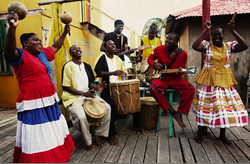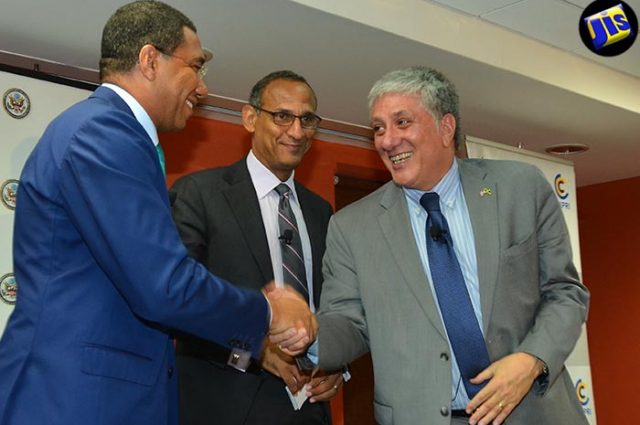The neighborhood itself is cool. You meet a lot of cool people that come through here; they move here from wherever they were from and add their culture. But it's definitely changed and gentrified. And I don't think that's a one-hundred percent 'bad' thing — there's pluses and negatives to everything. My roots are in the Caribbean and in Africa, more so than they are here, so I got to represent that. I embrace it, I love it. I'm always playing reggae. I have to force the employees to mix it up whenever I'm in the shop. If I don't, they'll just stick to hip-hop, but when I'm working, reggae is playing, since day one. [Customers] come in and get to feel that. It puts them in a Caribbean atmosphere, even for a few minutes.

People think, "How do you do this stuff?" With a calm head, you can do anything and this is no different. I'm a mental chemist, I guess. Fruits and everything is just trial-and-error, and then after that, it's movement, then you get the feel. Also because I drink the shyt everyday, I want to make it the way I would want to drink it myself. Nothing satisfies me more than making a drink for someone not used to this and just watching them enjoy it. If I can help someone enjoy something that's good for you and tastes good at the same time — that's my goal.
We're on pace with social media. There's always room for improvement: more advertising, more products, branding and building. The health consciousness in the world, the fact that people are going to want this, as opposed to the garbage they sell out there. Since I've been here, I've really noticed what I eat. I'm definitely not going to be here forever. I wouldn't mind opening up one of these wherever I go. And wherever I go, this is in my back pocket. I can do this anywhere because it's the same vibe I'm bringing to wherever it's at.

3. Peppa's Jerk Chicken
738 Flatbush Avenue, East Flatbush

JASON HUSSEY: Peppa's is a family business. When you're young, you start coming around. After a while, you start to work — that's if you want to work, it's totally your choice. And we just started to work, then started to work every other day, and then it became our job. The restaurant was opened in '94; it was called Danny & Peppa's at first. My uncle and his friend started it, and then they parted ways early 2004, then we moved down here and opened this one. I learned different things from different people. [My uncle] Garvin taught me the business, the groundwork; he taught you to be family. Everybody teaches you something different. Peppa himself laid the groundwork, but we always learn from each other.



JESSICA HUSSEY: The majority of Brooklyn has a Caribbean culture, from East Flatbush to Crown Heights to Canarsie. Caribbean culture is all over Brooklyn. Brooklyn is probably the capital of Caribbean culture. It makes you feel like you're a part of the community. That's who we associate with. We are Caribbean people. Our cultures are very similar, whether you're Jamaican, Bajan, Guyanese — we all came from an island with a sense of a better life. The area is predominantly Caribbean but now it's changing. It's okay, it's just a different variety of people living here, but they all coming here for food.
JASON:When people come here and eat a piece of our jerk chicken they get a piece of our culture, our upbringing, where we come from — St. Andrews, Jamaica. I want them to understand that we didn't grow up rich — we wasn't poor, but we're a strong group of people. That's still home for us. The community we came from, we still know the people. Some of our family is still there.


We appreciate all of Brooklyn and everyone who comes to our restaurant. Sometimes we have people who say they're coming from Pennsylvania, from Jersey, Connecticut, just to try our foods. I love all the customers, the customers is what keeps us open. We have some familiar faces. After years and years, it's like, Wow.
We have a new restaurant opening on Prospect Avenue and Nostrand. That's the second location in New York. We're just trying to grow. We're trying to expand the media advertising and social media. We'll be delivering on Grubhub and Seamless soon. It's different time that we live in. Before, you had to have a restaurant on the front page. Now you can have a restaurant in a corner, in a hole that nobody knows, but because of social media people will find you.

How Three Caribbean Restaurants Help Keep Brooklyn’s Island Pride Strong

People think, "How do you do this stuff?" With a calm head, you can do anything and this is no different. I'm a mental chemist, I guess. Fruits and everything is just trial-and-error, and then after that, it's movement, then you get the feel. Also because I drink the shyt everyday, I want to make it the way I would want to drink it myself. Nothing satisfies me more than making a drink for someone not used to this and just watching them enjoy it. If I can help someone enjoy something that's good for you and tastes good at the same time — that's my goal.
We're on pace with social media. There's always room for improvement: more advertising, more products, branding and building. The health consciousness in the world, the fact that people are going to want this, as opposed to the garbage they sell out there. Since I've been here, I've really noticed what I eat. I'm definitely not going to be here forever. I wouldn't mind opening up one of these wherever I go. And wherever I go, this is in my back pocket. I can do this anywhere because it's the same vibe I'm bringing to wherever it's at.

3. Peppa's Jerk Chicken
738 Flatbush Avenue, East Flatbush

JASON HUSSEY: Peppa's is a family business. When you're young, you start coming around. After a while, you start to work — that's if you want to work, it's totally your choice. And we just started to work, then started to work every other day, and then it became our job. The restaurant was opened in '94; it was called Danny & Peppa's at first. My uncle and his friend started it, and then they parted ways early 2004, then we moved down here and opened this one. I learned different things from different people. [My uncle] Garvin taught me the business, the groundwork; he taught you to be family. Everybody teaches you something different. Peppa himself laid the groundwork, but we always learn from each other.



JESSICA HUSSEY: The majority of Brooklyn has a Caribbean culture, from East Flatbush to Crown Heights to Canarsie. Caribbean culture is all over Brooklyn. Brooklyn is probably the capital of Caribbean culture. It makes you feel like you're a part of the community. That's who we associate with. We are Caribbean people. Our cultures are very similar, whether you're Jamaican, Bajan, Guyanese — we all came from an island with a sense of a better life. The area is predominantly Caribbean but now it's changing. It's okay, it's just a different variety of people living here, but they all coming here for food.
JASON:When people come here and eat a piece of our jerk chicken they get a piece of our culture, our upbringing, where we come from — St. Andrews, Jamaica. I want them to understand that we didn't grow up rich — we wasn't poor, but we're a strong group of people. That's still home for us. The community we came from, we still know the people. Some of our family is still there.


We appreciate all of Brooklyn and everyone who comes to our restaurant. Sometimes we have people who say they're coming from Pennsylvania, from Jersey, Connecticut, just to try our foods. I love all the customers, the customers is what keeps us open. We have some familiar faces. After years and years, it's like, Wow.
We have a new restaurant opening on Prospect Avenue and Nostrand. That's the second location in New York. We're just trying to grow. We're trying to expand the media advertising and social media. We'll be delivering on Grubhub and Seamless soon. It's different time that we live in. Before, you had to have a restaurant on the front page. Now you can have a restaurant in a corner, in a hole that nobody knows, but because of social media people will find you.

How Three Caribbean Restaurants Help Keep Brooklyn’s Island Pride Strong
















